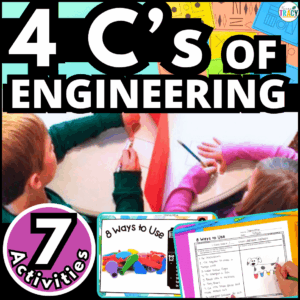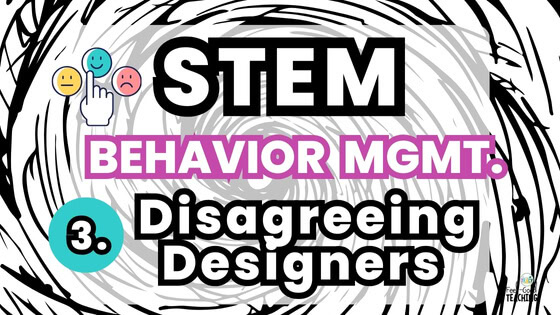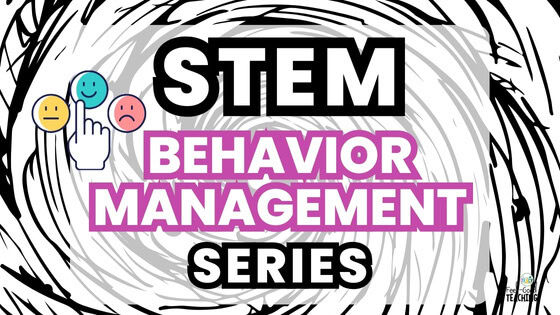In STEM group work, conflict management is tricky. Welcome back to the STEM Classroom Management Blog Series! Today we’re talking about how to guide students through respectful disagreement & turn conflict into collaboration.
If you’re just joining us, this series offers practical tips and resources to help educators navigate tricky behavior and group dynamics during STEM challenges.
Last time, we looked at strategies to help the quietest students in the room find their voice. (If you missed it, check out The Silent Teammate post here.)
Today, we’re talking about the other end of the spectrum: when students can’t stop disagreeing.
Let’s explore what to do with The Disagreeing Designers.
Meet the Disagreeing Designers
These students are highly engaged but can’t agree on anything. They may:
- Argue over which idea to build
- Ignore each other’s suggestions
- Refuse to compromise
- Compete instead of collaborate
They may not even realize they’re sabotaging the team effort. But as educators, we can guide them to shift from conflict to productive discussion.
Why STEM Conflict Happens
Some disagreement is natural, even healthy, in collaborative work. But in a classroom setting, it can quickly escalate if students lack the skills to resolve it respectfully.
Common root causes:
- Strong personal investment in their own ideas (first-class problem!)
- Lack of experience blending multiple design plans
- Poor listening or turn-taking habits
- Fixed mindset: “My idea is better.”
Your goal isn’t to eliminate disagreement; it’s to channel it into better collaboration.
Strategies for Managing Conflict During STEM Challenges
Here’s how to support students before, during, and after a challenge when disagreements threaten to derail progress.
🌍 Before the Challenge: Set the Ground Rules
1️⃣ Normalize disagreement. Start with this message:
“Great teams don’t always agree right away. It’s how you work through disagreements that makes you stronger.”
2️⃣ Create group norms together. List and agree on what respectful disagreement looks like:
- We listen before responding
- We explain our thinking
- We try to combine ideas
- We don’t interrupt or roll our eyes
3️⃣ Practice merging ideas with a mini warm-up. Give students two totally different concepts (e.g., a swing and a submarine) and challenge them to combine features into one design. It builds creative flexibility before the real challenge begins. (For more creative flexibility activities, check out Design Domino & STEM Improv.)
4️⃣ Choose the right rubric & share it. Whatever the behavior you want to work on, be sure it’s part of the rubric you’re using to evaluate the challenge. But don’t stop there. Review the rubric before the activity, emphasizing what a “4” looks like in each category so students know what they’re striving for.
I have several different rubrics, depending on the goals at any given time. The 4 Cs rubric works well for the beginning of the year or whenever you need to revisit working collaboratively. (When the 4 Cs are humming along, I switch to rubrics that are more process focused, but I recommend the 4 Cs until students are demonstrating them consistently in challenges.)
⏱️ During the Challenge: De-Escalate and Refocus
➡️ Use a structured compromise protocol. If two students are locked in disagreement, ask:
“What is one strong feature of each design?”
“Is there a way to combine both ideas?”
➡️ Encourage side-by-side sketching. Let each student draw their version, then compare. Often, visualizing both options reveals overlaps and sparks new solutions.
➡️ Bring the criteria & constraints list back into focus. Ask:
“Which idea best meets the challenge goals?”
“Which design uses fewer materials? Offers more stability?”
Letting the project needs guide the decision helps students depersonalize the conflict.
➡️ If needed, use a quick tiebreaker. When you’re short on time, allow:
- Team vote
- Random choice (coin flip or rock, paper, scissors)
- Split task: Try both designs in small form and test!
Remind students that once a choice is made, the team commits and moves forward together.
➡️ Multiple Iterations. If it’s possible to offer time to revisit the challenge for a second iteration (whole-group, Friday centers, early finishers, etc.) make it known during conflicts that they will have another chance to try different ideas.
➡️ Rubric reminders. As you’re circulating during the challenge, ask where they’d rate themselves now on the rubric for collaboration and whether they can keep up the good work, or make some tweaks to improve their teamwork before the challenge is over.
🔄 After the Challenge: Reflect on Team Dynamics
⭐️ Prompt reflection: Use questions like:
- Did we find a way to compromise?
- Did everyone get to share their idea?
- What helped us work through our disagreement?
- What could we try differently next time?
⭐️ Celebrate healthy disagreement. Point out when teams listened, debated respectfully, or found ways to blend ideas:
“I noticed you had two totally different designs at first, but you figured out a way to combine the best parts. That’s real teamwork.”
⭐️ Invite a group share or gallery walk. Let students explain how they overcame design conflict and what they learned. This is also the time to ask what ideas they want to try next time. Hearing others’ solutions builds strategy-sharing and community.
⭐️ Have students self-assess. Let students grade themselves on the rubric. If time, have them discuss in their group or whole-class what they could do next time to improve.
🧠 The Goal Isn’t Perfect Harmony
It’s okay if students disagree. In fact, they should. That’s how better ideas are built.
But our job is to help them practice conflict resolution in ways that strengthen, not weaken, the team.
With some structure and support, The Disagreeing Designers can become creative collaborators.
💡 Want a Free STEM Behaviors SEL Handbook?
I’ve put together a printable copy of these strategies, as well as navigating the other tricky STEM behaviors in this series. It’s perfect for keeping in your lesson planner or sharing at your next PLC or team meeting.
Looking for Creative Flexibility Activities?
For more practice on the 4 Cs of Engineering:

STEM Rubrics and Post-Build Routines:
✨ Next in the Series…
What happens when a student in the group checks out completely and says, “I don’t care”? In our next post, we’ll explore The Absent Contributor.
You can also catch up on earlier posts:
Explore all posts in the STEM Classroom Management Series here.
Pin it. Share it. Save it. Let’s build better teams, one STEM challenge at a time. 🚀
Every challenge is a chance to teach collaboration. Let’s help students disagree productively.








